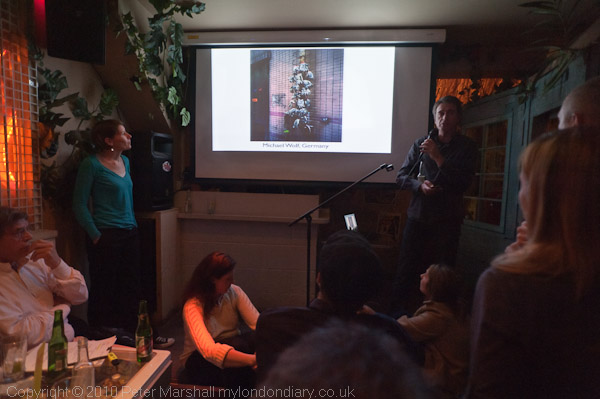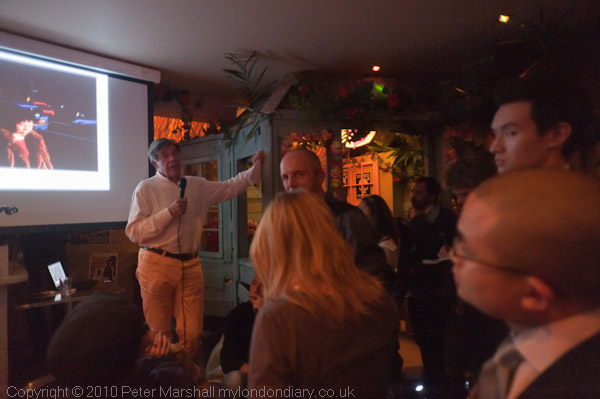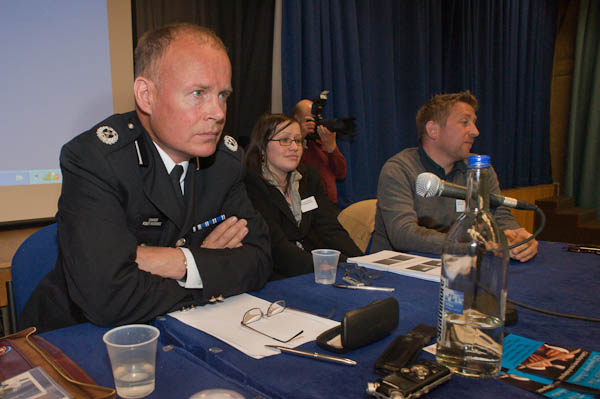Long ago, back in the days of film, every year around this time I used to lock away the colour stock and go out with only black and white in my cameras, as I knew otherwise I would waste far too much recording the changing colours of leaves. Had I got round to it I would have got around to printing a t-shirt for photographers with the message “Get over it – leaves turn brown in Autumn!”

Stephen McLaren talking and showing photographs at the Social at Barrio Central – and as this picture suggests it was dark and crowded there. 20mm f2.8 Nikon D700
I felt something related to this as I watched Stephen McLaren‘s presentation of images by some of the photographers features in the book ‘Street Photography Now!‘ at the first Photographers Gallery/BJP Social evening at Barrio Central in Poland St this evening, though rather than Autumn colours my thoughts were about pictures mainly about and created by strong shadows and unusual lighting conditions.
Of course light is one of the basic tools of the photographer – where would we be without it – but at least for me the aim isn’t to make pictures about it but to use it to illuminate (in every respect) the subject.
It would be wrong and impossible to propose a complete ban on taking such pictures. Books such as Trent Parke‘s ‘Dream Life‘ show how powerful they can be. But since Trent and rather many others have pretty well ploughed that furrow out perhaps we might turn to other fields?
Stephen McLaren showed some interesting work (and I very much liked his own picture which made use of the low angle sun on a nearby street despite the comments above – from his series Coupling) with at least one image from each of the photographers concerned that gained my admiration, which isn’t a bad average, but I was left wondering if some perhaps showed too much striving after what might be called ‘Flickr approval‘ and that perhaps the hardest thing to learn as a photographer is the power of understatement. And to repeat one of my old refrains, that photography isn’t about making pictures.
I also found it disturbing that the images appeared to be projected on screen at the wrong aspect ratio changing images in a normal format into near-panoramics (I think actually from 1.5:1 to about 1.7:1 – it is a problem with some screen resolutions.*) There was too a problem with the colour, with some images at least being greatly over-saturated. I would have hoped that two of our major photographic institutions could have coped rather better with screen resolutions and colour management and hope it’s an issue they address for further occasions. Surely we should treat photographers’ work with much greater respect.
On the train home I was entertained to hear a lengthy report by a photography student on the evening, and at least he had gathered the main point from lawyer Rupert Grey (of photography specialists Swan Turton), that on the street you can legally photograph anything you like.

Rupert Grey talking at the Social at Barrio Central
Perhaps the only thing that he said that was new to me was his opinion that the police probably never have the right to demand to view your images; I’d been fairly clear about this so far as journalists are concerned, but he went further to apply this to anyone taking photographs.
Most of us also know that the police have no right to delete images or demand that you do so, although in a number of cases – and he mentioned that of Martin Parr – police have insisted that photographers do so. In practice of course it isn’t a great problem, as so far the police haven’t realised that deleting files from your card doesn’t actually remove them. So long as you don’t take any more pictures on that card afterwards, it is a simple matter to recover them.
There were a few things – particularly in response to questions – that he perhaps might have been clearer about, at times because he failed to make clear the distinction between taking a photograph and publishing it. Working in public places you never need permission or model releases to take a picture, although sometimes it may be sensible to get a release or polite to ask. But many of the best pictures come from situations where neither is possible. But what he failed to explore was the increasing threat to photographers that the legal interpretation of the individual’s right to privacy – even in the absence of UK law – is already having on court judgements in this country.
Using a picture without a model release becomes a problem in contexts where that use might be defamatory. So, for example, using a picture of a person on the street to illustrate an article on drug addicts would be ill-advised unless the picture or other evidence clearly showed that person to be a drug addict. There is so far as I am aware no legal requirement for a model release to use any photograph in an advert (or in any other way), but it is a normal commercial requirement as it should remove the possibility of legal action. Contrary to popular opinion not all adverts or commercial work needs photographs to have a model releases – the last picture I came close to selling in that field was considered to be quite acceptable despite the presence of a recognisable person but no model release – but it is certainly normal practice to require one.
Grey also made it clear that there were no restrictions on photographing children – unless the images you produce are indecent. This can perhaps sometimes be a problem for street photographers in hot weather, when there may well for example be naked children running through fountains, playing in pools or running along beaches. To you or me, pictures of them might be perfectly innocent, but police and courts might take different view. And this is again an area where the privacy rights under European law are increasingly coming in to play – and at least one judge has made it clear in a judgement that the balance that has to be maintained between freedom of expression and privacy would be biased more towards privacy for minors.
I’ve heard Grey speak on various occasions before and he is obviously an expert in the field, but while it is good to know what the law is, we know that what police and others such as PCSOs, security staff and council employees try to enforce may be very much different – as examples such as the incident involving Parr demonstrate.
Perhaps the most useful and most sound piece of advice Grey gave about such situations was that photographers should be polite. I’d take that a little further and suggest that while where necessary insisting on our rights we should do so without unnecessary confrontation and where possible cooperate with the police and others. So I’m always happy to talk to any member of the public – whether in uniform or not – about what I’m doing, and where I think it appropriate to produce evidence of identity.

Commander Broadhurst at the NUJ photographers conference in May 2009 listens to photographers accounts of police violence.
Perhaps the most amusing part of his talk related to his conversation with Commander Broadhurst of the Met and a representative of ACPO. While it was good to hear of changes in their thinking about photographers, the suggestion from Broadhurst that police on the streets would all know about this seems laughable. http://re-photo.co.uk/?p=660 It was Broadhurst who said at an NUJ photographers’ conference in May 2009 “can anybody apply for an NUJ card who has a camera?” shocking all present by his total ignorance and lack of understanding of the UK Press Card scheme (more about this occasion here.)
So while there may well have been some changes, I think we can be pretty sure that most of the police on the street will know as much about these as they have about previous statements which gave essentially similar advice such as that sent by Assistant Commissioner John Yates to all MPS officers and staff last December.
I think there have been some indications of a better attitude towards photographers by police at demonstrations in London at least since their disastrous public performance at Bank in April 2009, and I welcome this, and hope that Broadhurst’s extreme optimism is well-founded. But I’m far from sure that this has as yet had any impression so far as the more general interactions between photographers and ‘officials’ of all types on the street away from protests.
Although the ‘Photographers Social’ seems a great idea, in practice it was too crowded, too hot and too uncomfortable, and the area was really not well suited to such a large event. Like quite a few others I left as soon as the two presentations were over for the comfortable bar (and real beer at rather lower prices) a few yards away. Perhaps the BJP/PG might investigate other venues in the area.
*Display Aspect Ratios
You should check any screen (or projector) by finding the screen resolution in pixels and comparing the ratio between width and height with the actual width and height of the image. Most displays allow you to run them at different resolutions, some or all of which may be unsuitable, but LED screens are best used at their native resolution, in the case of my monitor 1680 dots x 1050 lines.
So I’m writing this on a 1680×1050 pixel screen with an image display 454x 283mm, ratios of 1.6:1 and 1.604:1 – essentially identical.
Projector or monitor displays that give markedly different ratios for these two things are unsuitable for photographers.